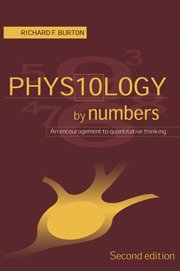Book contents
- Frontmatter
- Contents
- Preface to the second edition
- Preface to the first edition
- How to use this book
- 1 Introduction to physiological calculation: approximation and units
- 2 Quantifying the body: interrelationships amongst ‘representative’ or ‘textbook’ quantities
- 3 Energy and metabolism
- 4 The cardiovascular system
- 5 Respiration
- 6 Renal function
- 7 Body fluids
- 8 Acid–base balance
- 9 Nerve and muscle
- Appendix A Some useful quantities
- Appendix B Exponents and logarithms
- References
- Notes and Answers
- Index
3 - Energy and metabolism
Published online by Cambridge University Press: 06 July 2010
- Frontmatter
- Contents
- Preface to the second edition
- Preface to the first edition
- How to use this book
- 1 Introduction to physiological calculation: approximation and units
- 2 Quantifying the body: interrelationships amongst ‘representative’ or ‘textbook’ quantities
- 3 Energy and metabolism
- 4 The cardiovascular system
- 5 Respiration
- 6 Renal function
- 7 Body fluids
- 8 Acid–base balance
- 9 Nerve and muscle
- Appendix A Some useful quantities
- Appendix B Exponents and logarithms
- References
- Notes and Answers
- Index
Summary
To feel at home in this field one must be familiar with a variety of measures and units of energy – calories, joules, litres of respired oxygen, slices of bread, and so on. The more books or papers one consults, the more evident this becomes. Many of the early calculations in this chapter are intended primarily to help with this problem. Fortunately, physiology makes little use of such other units as kilowatt-hours, British thermal units and litre-atmospheres. Amongst calculations on metabolic rate are some to do with its dependence, in mammals generally, on body size (Section 3.10). Uses and limitations of such allometric scaling are then explored in relation to drug dosage, life span, heart rate, the metabolic cost of sodium transport and the rate of metabolic production of water (Sections 3.11–3.14).
Most emphasis is placed here on aerobic metabolism, and on glucose rather than on other metabolic substrates. The reader might like to re-work some of the calculations in terms of, say, anaerobic metabolism or fatty acids.
Amounts of energy and work are expressed here in terms of both kilocalories and kilojoules. When pairs of figures (i.e. kcal and kJ) are chosen for their convenience, or as round numbers, then they are not always exactly equivalent. Calculations on energy use are also to be found in Sections 4.7, 6.8, 9.4 and 9.5.
Measures of energy
The variety of units in which energy and work may be expressed does not help casual quantitative thinking.
- Type
- Chapter
- Information
- Physiology by NumbersAn Encouragement to Quantitative Thinking, pp. 27 - 47Publisher: Cambridge University PressPrint publication year: 2000



